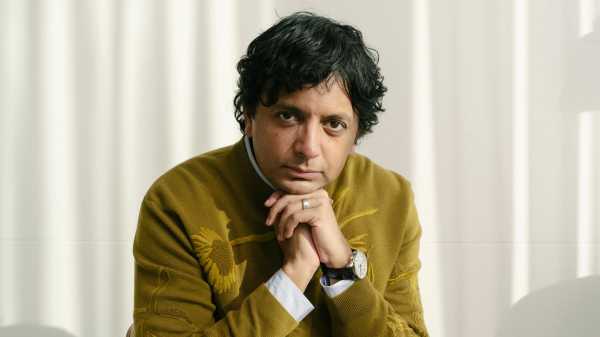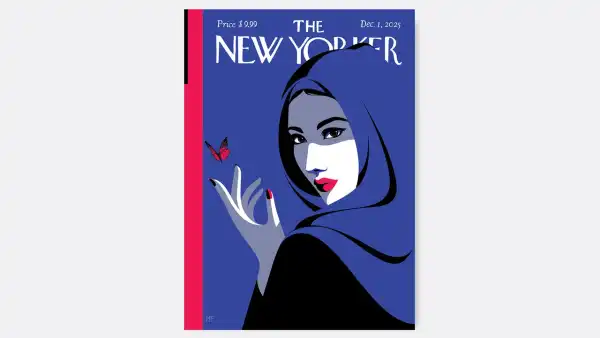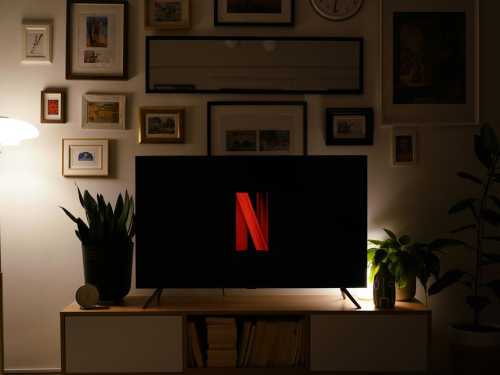
In M. Night Shyamalan’s new movie, “Knock at the Cabin,” a couple vacationing in rural Pennsylvania with their adopted daughter realize that they are not alone. A group of travellers is watching them from the trees and encroaching on the property. The films of Shyamalan are filled with such uninvited house guests. The big twist in “The Sixth Sense” (1999)—the one that turned its director into the most reliable American brand name in narrative trickery since O. Henry—finds its roots in a home invasion: a naked, emaciated mental patient appearing at Bruce Willis’s broken bedroom window. Intruders—be they human, monstrous, or extraterrestrial—figure into similarly unsettling set pieces in “Unbreakable,” “The Village,” and “The Visit.” Even Shyamalan’s flashy Will Smith vehicle, “After Earth” (2013), which has a crashing spaceship and futuristic monsters, pivots emotionally on a flashback featuring a breached family dwelling. The new film is an adaptation of a novel by Paul Tremblay, “The Cabin at the End of the World.” Shyamalan’s title lacks the apocalyptic overtones but has an added hint of playful urban-legend malevolence: that “knock” is the terrible sound of letting the wrong one in.
“These are just my fears, dude,” Shyamalan told me via Zoom recently. “I got married when I was twenty-two, and I’ve got three girls. We’re all incredibly close. My parents live nearby; my sister lives nearby. We have kept the family unit super tight, at the center of everything. So the fear of ‘Where is your daughter?,’ ‘She was supposed to be home,’ or ‘She didn’t call’—those are what start me writing. It’s working through these fears and then attaching them to some kind of supernatural manifestation.” Shyamalan was calling from his family compound in Pennsylvania, a sprawling property that houses his business offices and editing suite. He was sitting at a desk, in front of an interior stone wall lined with family photos and a small red basketball, a token of his avowed N.B.A. fandom. In one corner, a black director’s chair emblazoned with his name made me think of the Hitchcockian cameos that Shyamalan has been making in his films ever since “The Sixth Sense”—including one, in the 2021 sleeper hit “Old,” as a sinisterly omniscient filmmaker.
Still fit and slightly boyish at fifty-two, Shyamalan has large eyes that suit his standing as a master of suspense, and he’s learned how to flash them mysteriously throughout years of photo shoots and interviews. As a filmmaker of color who came up before Hollywood’s millennial-era reckonings with diversity, Shyamalan resisted being defined by difference without downplaying it, either. “Maybe because I’m an immigrant, because I’ve always been, like, the one Indian kid in school and all that stuff, I’ve never been able to quite fit in,” he told me. In 1970, when he was six weeks old, Shyamalan emigrated from Puducherry, India, to the United States with his parents, who were doctors. He attended Catholic private schools, where he stood out in part as an academic overachiever. “Being a bit of an outsider has been O.K.,” he said. “You always have the desire to be accepted, but I wanted to be able to say, ‘These are the value systems that are most important to me, and I’ll burn down the house for them.’ ”
Talk to Shyamalan long enough about any subject, and he’s likely to relate it back to how he hopes to connect with his audience. “Our industry has a set of rules,” he said. “But I believe—and maybe this is naïveté—that there’s another set underneath that, that supersedes that at the end of the day.” If you adhere to your own artistic principles, he added, “you may not win that day, but you will win in aggregate.” In conversation, he is poised yet disarmingly transparent; he likes having his work interpreted but doesn’t want it reduced to a formula. His evident pride in his films doesn’t come off as arrogant so much as affable, and even his humblebrags are couched in introspection. “You know, things are going well for me, and it makes me scared,” he said. “I wake up every morning really scared now, bro. Maybe it’s just all of our paranoias, when you feel grateful, like, ‘Oh, my God, there’s a price to pay’ or something like that, you know?”
Shyamalan recently appeared on “The Late Show with Stephen Colbert” to help the host “Shyamalanify” his broadcast, which meant poking fun at the tropes that have defined his public image since “The Sixth Sense”: his gift for slow-burning dread; his cultivation of a mystical offscreen persona; his penchant for twist endings. For a time, in the late two-thousands, the name M. Night Shyamalan was something of a pop-cultural punch line, which was perhaps a predictable price to pay for the kind of Spielbergian hype that accrued around his early work. But the derision that Shyamalan films provoked also had to do with his peculiar earnestness in an irony-seeped, post-Tarantino cinematic moment. As a screenwriter, Shyamalan doesn’t really do banter or one-liners; after the release of “Old,” the critic Sam Adams started a Twitter imbroglio when he joked that he thought it was brave that Shyamalan had been making movies for twenty-five years without learning how to write dialogue. It was a cheap shot that nevertheless got at something about the filmmaker’s contradictions. Shyamalan’s artistic voice is defined by a mixture of eloquence and stiltedness, boldness and fragility. Love them or not, you wouldn’t mistake one of his films for anyone else’s.
Part of what some observers found wearing was Shyamalan’s attempt to control his own media narrative. In 2004, he appeared in a Syfy-channel mockumentary called “The Buried Secret of M. Night Shyamalan,” a plodding faux hagiography that purported to investigate his uncanny, possibly paranormal filmmaking genius but was really just a self-aggrandizing publicity stunt to promote “The Village.” Two years later, Michael Bamberger published “The Man Who Heard Voices,” a behind-the-scenes account of Shyamalan’s making of “Lady in the Water” (2006) that Janet Maslin called “not just a puff article but a full-length, unintentionally riotous puff book.” Despite Bamberger’s obvious thrall to Shyamalan’s charisma, the narrative nonetheless revealed notes of petulance and insecurity in his directorial approach—the flip side to his principled, prepossessing confidence. “Lady in the Water” centered on a wayward nymph named Story (Bryce Dallas Howard), who is discovered in the pool of a Philadelphia apartment complex and is looking for a path back to her mythical homeland. The film features Shyamalan in a larger-than-usual supporting role, as a man who learns, via prophecy, that his writing is destined to change the world, but not before resulting in his martyrdom. Reviewing it in the Times, Manohla Dargis, one of many critics to pan the film, wondered if Shyamalan had “lost his creative marbles.”
It’s a fine line between earnestness and delusions of grandeur, but talking to Shyamalan it’s clear that “Lady in the Water” came from an honest place. The movie, which now enjoys something of a cult status, luxuriates in its own goofy convolutions, and Shyamalan’s instinct to cast himself as a man trying to protect Story—pun intended—reflects his belief in narrative as a precious, fragile commodity. He told me, “In some ways, that was my favorite of my movies and the most me of my movies.” One of Shyamalan’s most familiar motifs is of torrential baptismal cleansing—a concept that tends to figure into his climaxes, as at the end of “Lady,” which builds to a gorgeous shot from the bottom of a swimming pool during a rainstorm, and “Signs,” where the alien villain is vanquished by some spilled glasses of water. “I guess I’ve grown up in both Catholic and Hindu religions, where water is so critical,” Shyamalan said. “It could purify you and be a symbol of rebirth and renewal and starting over, or it’s so powerful it could just eradicate you.” When he spoke about individual scenes or moments from his movies, he sounded moved. Of “Lady in the Water,” he said, “I remember writing the line when Cleveland”—the superintendent character played by Paul Giamatti—“is getting emotional talking about his family at the end. He says, ‘I miss your faces, they remind me of God,’ or something, and when I wrote that I choked up.”
With his career at a low ebb, in the early twenty-tens, Shyamalan veered in a generative new direction by self-financing a found-footage horror-comedy, “The Visit,” with a budget of just five million dollars. Betting on his ability to adapt to a form antithetical to his usual big-budget studio productions, he ended up with a genre-bending hit. “The Visit” is a darkly funny riff on Brothers Grimm clichés, using an ingenious formal gimmick of an inept, first-person teen-age cinematographer to permit the real director to deploy tricky, Kubrickian compositions: a static shot of a kitchen is held until it radiates with menacing domesticity. For all its modesty, the film may be Shyamalan’s masterpiece, taking his obsessions with unreliable narratives and unsafe spaces and using them ruthlessly against the viewer. “ ‘The Visit’ really was like re-starting again for me,” Shyamalan said. “Like, if I was an N.B.A. player, I’m just gonna go play street ball again.”
A year later, the “Sixth-Sense”-ian psycho-thriller “Split” (2016)—about a serial killer with multiple personalities—revealed Shyamalan’s best twist in years: sold as a straight-up psycho-horror film, it was actually a stealth sequel to 2000’s much loved “Unbreakable,” starring Willis and Samuel L. Jackson. With its comic-book-style frames and pervasive sense of moody, millennial angst, “Unbreakable” effectively anticipated the Marvelization of American cinema, and “Split” gave Shyamalan his own freestanding superhero franchise of sorts. The third movie in the series, “Glass” (2019), centered on the frail “Unbreakable” mastermind played by Jackson, now recast as a tragic antihero. Shyamalan adroitly sidesteps blockbuster tropes to create a combination send-up-slash-critique of the superhero genre; he even decided to forgo any kind of big action climax. “I kept saying, ‘That’s where the Marvel movie would be,’ ” Shyamalan recalled. “We get tripped up before we get to the ending.”
“Knock at the Cabin” is replete with Shyamalanian trappings: a confined location, a parable-like narrative, cosmic stakes, a surprise conclusion. From a certain angle, the movie almost looks like self-parody, which is why it’s interesting to note that it’s one of his rare features developed from someone else’s material. Shyamalan was originally attached only as a producer, but, after the initial production fell through, the rights holders returned and asked him if he wanted to make it himself. “I just started to see the images, and it was a little bit like I couldn’t stop myself,” Shyamalan said.
The first image of the movie—an extreme closeup of a grasshopper—sets up a series of ominous power dynamics. The insect is helpless in the tender grasp of eight-year-old Wen (Kristen Cui), whose amateur entomology expedition is interrupted by the appearance of a figure who dwarfs her in turn. It is the hulking yet soft-spoken Leonard, a second-grade teacher played with great presence by a small-voiced Dave Bautista. The disparity in their sizes is touching, but also frightening: when they shake hands, it looks as though Wen’s arm might come out of its socket. In fact, Leonard’s gentle-giant act does belie a threat, although it’s not one that Wen and her parents—Eric (Jonathan Groff) and Andrew (Ben Aldridge)—could possibly anticipate. He’s travelled to the cabin with a group of followers to elicit a sacrifice on behalf of humanity: the family must kill one of its members to stave off the end of the world. Leonard’s job is not to commit harm but to make a compelling pitch.
I asked Shyamalan about the theme of belief that runs through many of his films. In “Unbreakable” and “Signs,” the protagonists have to be convinced either of their own superpowers or of the presence of some higher intelligence. “The Village” plays as a critique of authoritarian propaganda. In almost every case, faith seems elusive, but when it comes—justified or not—it’s profound and irreversible. “This one is really more about what we believe in each other: we don’t believe in each other, and we give up,” he said, adding, “We have this preprogrammed reaction to protect what is ours.” Like many of Shyamalan’s films, “Knock at the Cabin” possesses a certain visceral force, including bursts of violence that are all the more disturbing for occurring mostly offscreen. (“I want the audience to cross the line, not me,” he said. “I think it’s more powerful when they finish the statement.”) His most daring choice, though, has to do with the ending, which radically departs from that of the novel and, in doing so, reshapes the material’s meaning.
Shyamalan told me that he thinks his version of the story could be seen as “darker.” Without spoiling anything, I’ll say that the ending is more decisive than the novel’s, and perhaps more idealistic. The same earnestness that has sometimes made Shyamalan vulnerable to criticism is also what keeps his movies from succumbing to easy bleakness. “We’re all suffering, and we all are trying to stop our shutdown modes from coming on,” he said. “That’s a numbing choice, right? To say, ‘I’m out. I can’t be in this anymore.’ ” In Shyamalan’s cinema, detachment—for the director, or for the audience—is not an option, which is why, instead of a merely limber exercise in adaptation, “Knock at the Cabin” has the heft of a personal work. The rich, revivifying symbolism of the film’s final scenes is inscribed in a visual language that belongs solely to its director.
“I think about some of the people that I look up to, who are on my walls—the Hitchcocks and the Kubricks and all the masters,” Shyamalan said. “What I admire about them is that lack of being able to make them change the cinematic value system that they have, which is so inspiring, and I think it’s why they’ve endured.” He went on, “When somebody is a hundred per cent themselves, the system says it’s terrible, and everybody is making fun of it. But you close the door, and that painter or that songwriter or that filmmaker or that author gave you permission. You see them so clearly, and it’s amazing how they exist with their flaws. And you somehow feel more empowered.” ♦
Sourse: newyorker.com






